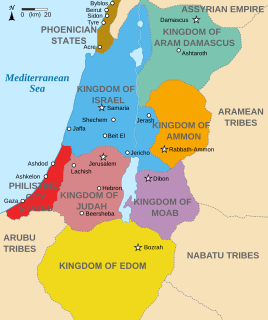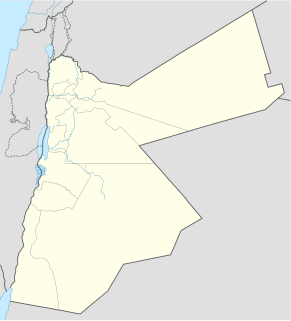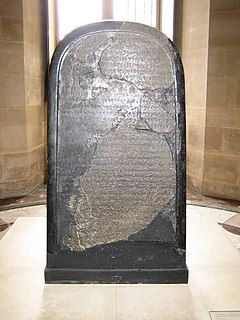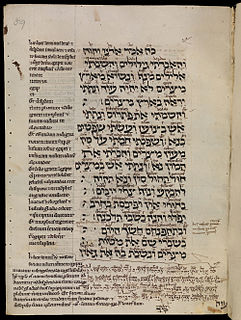
Ammon was an ancient Semitic-speaking nation occupying the east of the Jordan River, between the torrent valleys of Arnon and Jabbok, in present-day Jordan. The chief city of the country was Rabbah or Rabbath Ammon, site of the modern city of Amman, Jordan's capital. Milcom and Molech are named in the Hebrew Bible as the gods of Ammon. The people of this kingdom are called "Children of Ammon" or "Ammonites".

Hezekiah was, according to the Hebrew Bible, the son of Ahaz and the 13th king of Judah. Edwin Thiele concluded that his reign was between c. 715 and 686 BC. He is considered a very righteous king by the author of the Books of Kings. He is also one of the most prominent kings of Judah mentioned in the Bible and is one of the kings mentioned in the genealogy of Jesus in the Gospel of Matthew.

Nabu is the ancient Mesopotamian patron god of literacy, the rational arts, scribes and wisdom.

Heshbon was an ancient town located east of the Jordan River in what is now the Kingdom of Jordan, historically within the territories of ancient Ammon. Today, it is a ruin, bearing its old Arabic namesake, Tell Ḥesbān, located ca. 9 kilometers (5.6 mi) north of Madaba.
Horonaim is a city in Moab, mentioned in two Hebrew Bible oracles against the nation of Moab: in the Book of Jeremiah, and in the Book of Isaiah,. In 2 Samuel, an addition from the Septuagint text is sometimes translated as Horonaim, although it possibly derives from as little as a preposition.
Aroer is a biblical town on the north bank of the River Arnon to the east of the Dead Sea, in present-day Jordan. The town was an ancient Moabite settlement, and is mentioned in the Bible.

Dhiban is a Jordanian town located in Madaba Governorate, approximately 70 kilometres south of Amman and east of the Dead Sea. Previously nomadic, the modern community settled the town in the 1950s. Dhiban's current population is about 15,000, with many working in the army, government agencies, or in seasonal agricultural production. A number of young people study in nearby universities in Karak, Madaba, and Amman. Most inhabitants practice Islam.
Bamoth-Baal was an elevated point in the land of Moab mentioned in the Hebrew Bible. It was allotted to the Tribe of Reuben, and included with a list of towns near Heshbon. It is probably identical with the Bamoth between Nahaliel and the "valley that is in the country of Moab, to the top of Pisgah", mentioned in the list of stopping-places in Numbers 21:19-20.
Bethbamot in the Moabite Stone, line 27, may also be considered as connected with it.

King Mesha of Moab was a king of Moab in the 9th century BC, known most famously for having the Mesha Stele inscribed and erected at Dibon. In this inscription he calls himself "Mesha, son of Kemosh[-yatti], the king of Moab, the Dibonite."
Kir of Moab is mentioned in the Hebrew Bible as one of the two main strongholds of Moab, the other being Ar. It is probably the same as the city called Kir-haresh, Kir-hareseth, and Kir-heres. The word Kir alludes to a wall or fortress. It is identified with the later city Al Karak.

Edom was an ancient kingdom in Transjordan located between Moab to the northeast, the Arabah to the west and the Arabian Desert to the south and east. Most of its former territory is now divided between Israel and Jordan. Edom appears in written sources relating to the late Bronze Age and to the Iron Age in the Levant, such as the Hebrew Bible and Egyptian and Mesopotamian records. In classical antiquity, the cognate name Idumea was used for a smaller area in the same general region.
Ar is mentioned in the Hebrew Bible several times as a city of ancient Moab. While the exact location is unknown, it is likely to have been in the southern part of the Arnon Valley, which is the present day Wadi Mujib gorge in Jordan. The city was one of Moab's most prominent, being listed by the prophet Isaiah in his denunciation of the Moabite nation. Matthew Poole suggested that "the city was seated in an island in the middle of the river".
Isaiah 15 is the fifteenth chapter of the Book of Isaiah in the Hebrew Bible or the Old Testament of the Christian Bible. This book contains the prophecies attributed to the prophet Isaiah, and is a part of the Book of the Prophets. This chapter and the following chapter deal with the forthcoming history of Moab.
Isaiah 16 is the sixteenth chapter of the Book of Isaiah in the Hebrew Bible or the Old Testament of the Christian Bible. This book contains the prophecies attributed to the prophet Isaiah, and is a part of the Book of the Prophets. This chapter continues the proclamation concerning Moab commenced in the previous chapter.
Isaiah 17 is the seventeenth chapter of the Book of Isaiah in the Hebrew Bible or the Old Testament of the Christian Bible. This book contains the prophecies attributed to the prophet Isaiah, and is one of the Books of the Prophets. The New King James Version describes this chapter as a "proclamation against Syria and Israel".
Isaiah 25 is the twenty-fifth chapter of the Book of Isaiah in the Hebrew Bible or the Old Testament of the Christian Bible. This book contains the prophecies attributed to the prophet Isaiah, and is one of the Books of the Prophets. Chapters 24-27 of Isaiah constitute one continuous poetical prophecy, sometimes called the "Isaiah Apocalypse".

Ezekiel 25 is the twenty-fifth chapter of the Book of Ezekiel in the Hebrew Bible or the Old Testament of the Christian Bible. This book contains the prophecies attributed to the prophet Ezekiel, and is one of the Books of the Prophets. This chapter contains the oracles against 4 nations: Ammon, Moab, Edom, and Philistia. The prophecies of God's vengeance against these and other foreign nations are recorded in other books of the prophets such as Isaiah, Jeremiah and Amos.

Jeremiah 48 is the forty-eighth chapter of the Book of Jeremiah in the Hebrew Bible or the Old Testament of the Christian Bible. This book contains prophecies attributed to the prophet Jeremiah, and is one of the Books of the Prophets. This chapter is part of a series of "oracles against foreign nations", consisting of chapters 46 to 51. In particular, chapters 46-49 focus on Judah's neighbors. This chapter contains the poetic oracles against Moab.
The Land of Kir is a location mentioned in the Hebrew Bible, where the Arameans are said to have originated from. It is also the place to which Tiglath-Pileser III of Assyria carried the Aramean captives after he had taken the city of Damascus and conquered the kingdom of Aram-Damascus. Isaiah 22:6 mentions it together with Elam, implying an association between the two. This "Kir" is situated east of the Euprates or the Tigris River. Some scholars have supposed that Kir is a variant of Cush (Susiana), on the south of Elam. Other scholars believe that the Land of Kir is a location at Carma, an ancient city on banks of the Mardus River in modern-day Iran, or an area on the Kar River in the northern reaches of Ancient Armenia. Some Jewish scholars believe the Land of Kir to be located at Ihi Dekirah, a place east of the Euphrates River about halfway between Anah and Babylon, near Hīt in modern-day Iraq.









